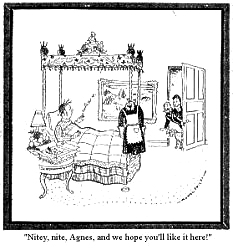
Nitey nite, Agnes and we hope you'll like it here!'
Dublin Opinion
Daughters of labourers and small farmers often went straight from school into 'service.' The numbers peaked in 1881 when nearly half of all women in paid employment in Ireland were indoor servants. From then on the numbers declined but in 1911, there were still over 125,000 female indoor servants, the vast majority of them in single-servant households and this was still the largest single source of paid work for women until the 1950s.
Employers were mostly middle-class business or professional people living in suburban areas of cities and towns. They advertised for smart girls who were clean, honest, humble, obedient, respectable and young. They might specify a girl of their own religion, particularly for looking after children. They often provided lodgings in an attic room and generally the same food as the family ate. Wages varied but depending on skill and experience, could be moderately generous.
Indoor servants often worked in basement kitchens and sculleries. They lit fires, prepared food from its raw state, digging and cleaning vegetables, slaughtering, plucking and cleaning fowl, cooking meals, making bread, cakes and jam. They did the washing up, cleaned and dusted rooms, emptied slops and polished and scrubbed. Families in larger homes who could afford two or more servants employed a cook, nurse, parlour maid, house maid, general servant, etc. These servants were usually expected to keep to themselves. They often had separate entrances from the family and in some large houses they moved around the outside of the house through a tunnel so they would not be in the way of family or visitors.
Compared with the rest of the female population, a high proportion of indoor servants never married. Employers often stated in advertisements that no 'followers' (male friends) were allowed and hours of work were so long and irregular that servants had little time for social life.
Domestic servants had few rights in their employment and many were exploited or dismissed, especially when they were sick or got older. Their prospects of employment declined sharply after they reached their 40s as employers considered young women more likely to be obedient and healthy. Nearly half were under 25 in 1911 and there was a high proportion of older servants in workhouses and lunatic asylums.
It was difficult in Ireland as in other countries for trade unions to recruit indoor servants in order to persuade them to better their lot. They tended to be isolated and they might form personal relationships with the women and children they worked for, move from one job to another, fear being sacked or getting a poor reference. Many looked on service as a temporary occupation prior to marriage, so why bother? However, they benefited from various social welfare schemes brought in by the British and Irish governments from 1906 on.
Young women enjoyed a greater variety of opportunities during the twentieth century. Many preferred to work in shops, factories and hospitals or to emigrate. Now the desperation of well-off women with no domestic help was the subject of humorous comment - though labour-saving appliances eventually came to their rescue.

Nitey nite, Agnes and we hope you'll like it here!'
Dublin Opinion